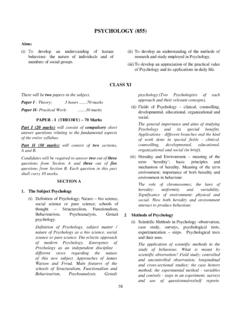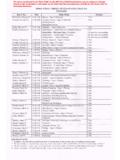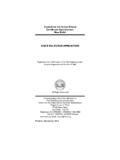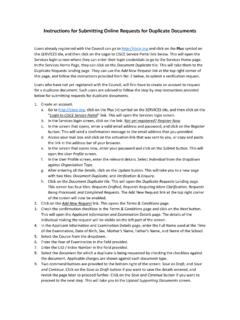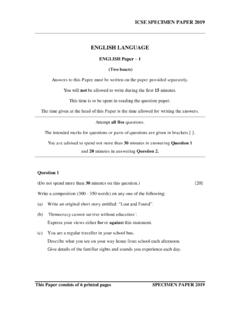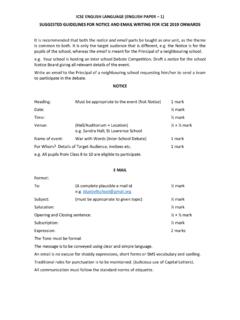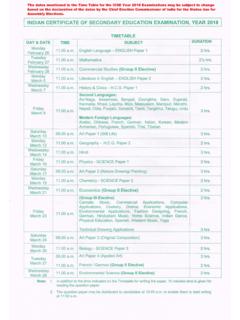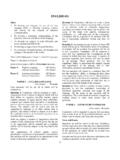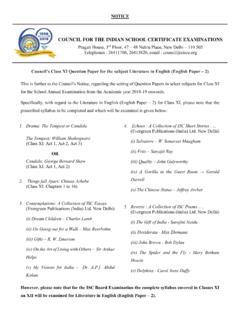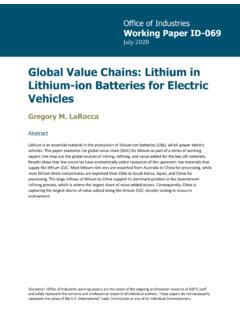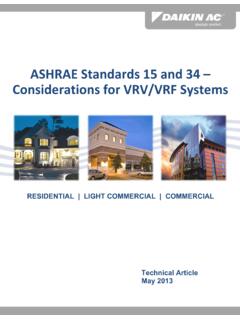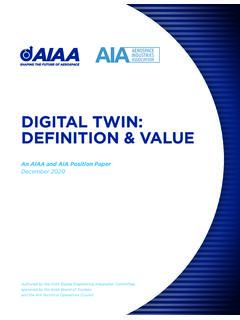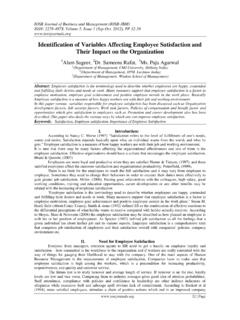Transcription of ISC SEMESTER 2 EXAMINATION SPECIMEN QUESTION PAPER …
1 ISC SEMESTER 2 EXAMINATION . SPECIMEN QUESTION PAPER . PHYSICS PAPER 1 (THEORY). ---------------------------------------- ---------------------------------------- -------------------- Maximum Marks: 35. Time allowed: One and a half hour Candidates are allowed an additional 10 minutes for only reading the PAPER . They must NOT start writing during this time. ---------------------------------------- ---------------------------------------- ------------------------------------- All questions are compulsory. This QUESTION PAPER is divided in 3 Sections A, B and C. The intended marks for questions are given in brackets [ ]. All working, including rough work, should be done on the same sheet as and adjacent to the rest of the answer. Answers to sub parts of the same QUESTION must be given in one place only. A list of useful physical constants is given at the end of this PAPER .
2 A simple scientific calculator without a programmable memory may be used for calculations. ---------------------------------------- ---------------------------------------- ------------------------------------- SECTION A 7 MARKS. QUESTION 1. (i) What is meant by a wavefront? [1]. 6 -1. (ii) Find the de Broglie wavelength of electrons moving with a speed of 7 10 ms . [1]. (iii) State how a p-type semiconductor will be obtained from a pure crystal of a [1]. semiconductor. (iv) In case of a regular prism, in minimum deviation position , angle made by the [1]. refracted ray (inside the prism) with the normal drawn to the refracting surface is: (a) 90 . (b) 60 . (c) 45 . (d) 30 . 1. (v) In Young's double slit experiment, what is the effect on fringe pattern if the slits [1]. are brought closer to each other?
3 (a) Fringes disappear. (b) Fringe width increases. (c) Fringe width decreases. (d) Fringe width remains unaltered. (vi) First line of Balmer series (H ) in the spectrum of hydrogen is obtained when an [1]. electron of hydrogen atom goes from: (a) 2nd orbit to 1st orbit (b) 2nd orbit to 3rd orbit (c) 3rd orbit to 2nd orbit (d) 3rd orbit to 1st orbit (vii) Which of the following graphs correctly represents the variation of maximum [1]. kinetic energy (Ek) of photoelectrons with the frequency ( ) of the incident radiation? (a). (b). (c). (d). 2. SECTION B 10 MARKS. QUESTION 2 [2]. (i) What is meant by Constructive interference? (ii) In Young's double slit experiment, what should be the phase difference between the two overlapping waves to obtain 5th dark band/fringe on the screen? QUESTION 3 [2]. (i) A thin converging lens of focal length 5cm is used as a simple microscope.
4 Calculate its magnifying power when image formed lies at: (a) Infinity. (b) Least distance of distinct vision (D = 25 cm). OR. (ii) A thin converging lens of focal length 12cm is kept in contact with a thin diverging lens of focal length 18cm. Calculate the effective/equivalent focal length of the combination. QUESTION 4 [2]. (i) Define angular dispersion. (ii) State any one difference between a primary rainbow and a secondary rainbow. QUESTION 5 [2]. Explain the following terms: (i) Intrinsic semiconductor. (ii) Extrinsic semiconductor. QUESTION 6 [2]. (i) Calculate maximum kinetic energy of photoelectrons emitted by a metal (work function = 1 5eV) when it is illuminated with light of wavelength 198 nm. OR. (ii) Calculate the minimum amount of energy which a gamma ray photon should have for the production of an electron and a positron pair.
5 3. SECTION C 18 MARKS. QUESTION 7 [3]. (i) In a single slit diffraction experiment, how does the angular width of the central maxima change when: (a) screen is moved away from the plane of the slit? (b) width of the slit is increased? (c) light of larger wavelength is used? OR. (ii) Using Huygen's wave theory of light, prove Snell's law of refraction of light. QUESTION 8 [3]. Draw a ray diagram of a refracting astronomical telescope when final image is formed at infinity. Also write the expression for its angular magnification (magnifying power). QUESTION 9 [3]. Radius of curvature of an equi convex lens of glass (n = 1 5) is 30 cm. Find its focal length. An object of height 5 0 cm is placed at a distance of 60 cm from the optical centre of the lens. Find the position and the height of the image formed.
6 QUESTION 10 [3]. On the basis of Bohr's theory, derive an expression for the radius of the nth orbit of an electron of hydrogen atom. QUESTION 11 [3]. Read the passage given below and answer the questions that follow. Mr. Ravi had been living in a small town with his family for many years. He decided to shift to a city when he learnt that a nuclear power plant would be built in his town. His son Prakash, who was a science teacher, did not agree with his father's decision. Prakash explained to his father how mass defect during nuclear fission released energy. He assured his father that the authorities were taking all the possible safety measures to avoid any kind of nuclear mishap. Mr. Ravi understood the scientific explanation given by his son and decided not to shift to another place. (i) What is the cause of energy generation of a nuclear reactor during nuclear fission?
7 4. (ii) Write one nuclear reaction for nuclear fission that takes place in a nuclear reactor. (iii) Give the formula for the energy generation that takes place in the nuclear reactor. QUESTION 12 [3]. (i) Answer the following questions. (a) Draw the circuit diagram of a full wave rectifier. (b) Draw labelled graphs showing the input and output voltages. OR. (ii) With reference to Semiconductor Physics, (a) Name the diode that emits spontaneous radiation when forward biased. (b) Draw a labelled energy band diagram for a semiconductor. (c) Name the process that causes depletion region in a p-n junction. Useful Constants & Relations: 1 Mass of electron/positron m 9 1 10-31 kg 2 Charge of an electron e 1 6 10-19 C. 3 Speed of light in vacuum c 3 0 108 ms-1. 4 Planck's constant h 6 6 10-34 Js 5 1nm = 1 10-9 m 6 1eV = 1 6 10-19 J.
8 5.
